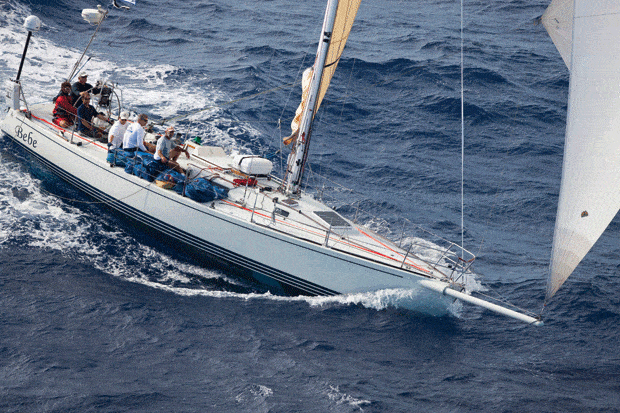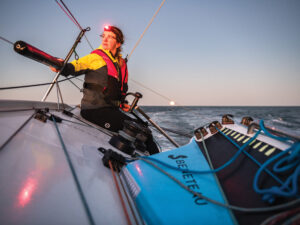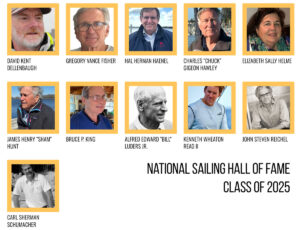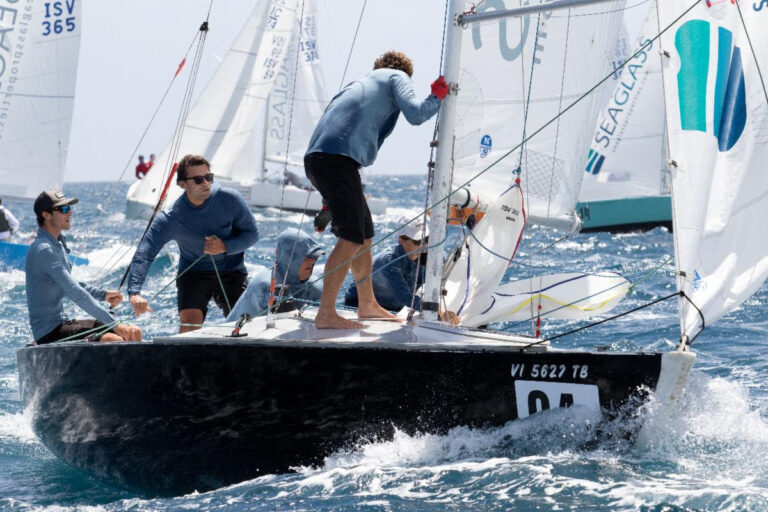
Sails on the weather rail
What’s the least exciting part of our sport? Sitting on the windward rail for hours or days at a time, leaning out over the lower lifeline until the legs go numb. Hiking on boats with lifelines sucks, but the reality is that wide boats require us to hike. The harder we hike, the faster we go. It’s not as though hiking is cool or even remotely attractive. When we subject our crews to hours creased over the lifelines they look like runners finishing a marathon: completely spent and drooling on themselves. It’s really unattractive.
Yet even for the most masochist buoy racers, hiking during a long offshore race presents a whole new level of misery. Take the Newport Bermuda Race, for example. It’s typically an upwind or tight-reaching racecourse where crews have been known to hike for days at a time. Not hours. Days. Many wide modern boats are forced to bring far more crew than necessary to sail effectively simply because they need the extra weight for stability. Excess crewmembers park their butts on the rail from start to finish.
All offshore boats have at least a few bunks that are positioned such that a crewmember’s body weight is actually outboard, sometimes slightly more so than the people sitting above them on deck. That’s all well when the crew is actually sleeping, but every time there’s a watch rotation, all that bunk weight isn’t where it’s supposed to be because people are out of their berths, getting their gear on or off, eating chow, talking with the navigator, or doing anything else to avoid returning to the rail. With a few bodies off the rail or out of berths every three hours or so, the boat is not sailing to its full potential for considerable lengths of time. This is slow, which is why a lot of crew forego the berth and just tough it out, especially during shorter offshore overnight races, leaning semi comatose over the lifelines. Again, that’s not my idea of fun, but what are we to do about it?
First, during offshore races we don’t allow any part of a crewmember’s body outside the lifelines—period. It’s a simple rule that can be adopted. Secondly, allow the stacking of any and all sails on deck. Stacking is simple, and it also eliminates one of the most unenforceable rules in all of sailing. Moving sails to the high side on deck from down below gives the boat more stability, makes the boat faster, and so much more.
My top reasons to allow stacking, in no particular order, are as follows:
1. The weight is where it should be, the boat is faster, and the team gets to its destination more quickly.
2. The stinky, wet sails spend all their time on deck, and life below is 100 times more comfortable. The interior is drier because you aren’t dragging wet sails up and down all the time, typically with saltwater showering all those nice cherry cabinets.
3. There is more space below to live, making it a better environment.
4. Because the sail stack is on the rail, it’s impossible for people to hike. Sitting on the stack creates a lot of windage so typically crew sit just inboard of the stack, where they are protected from wind, water, and waves.
5. With so much weight already in the right place, you can sail with a reduced crew number. This means less food, less gear below, fewer plane flights, less organization, and, for the people onboard, plenty of jobs to keep them engaged in the race.
6. It’s safer because the sails are strapped down and block the nastiest waves and spray in heavy air.
7. It allows the sails to be legally moved fore and aft, making boats easier to sail and faster on windy reaches and runs—when most of the weight should be near the back of the boat. In light air, the sails go forward in order to reduce wetted surface in the transom, and again make the boat faster.
8. Any boat can be retrofitted to store the sails on the rail with just a few simple modifications.
9. Crews will be more likely to use the bunks below, have real watch systems, and sleep more. A properly rested crew is faster and more alert, which improves safety.
One of the primary arguments against stacking is safety, but I have sailed and raced more than 100,000 miles on a boat (Volvo 70) that allows for the stacking of sails on deck. Like anyone else with a lot of experience on these boats, I guarantee that the windier and wetter a race is, the safer you’ll feel being able to duck behind the stack of sails on deck.
On faster, modern boats it’s crucial to move weight aft when the boat really starts flying. Do you want to keep all your crew on deck hovering in the aft corner, sleep deprived? Or would you prefer the ability to move the sails aft and help keep the bow out of the water and the water off the deck?
The only drawback is tacking or jibing. For sure, it takes a few more minutes to move the stacks, but on smaller boats it would be easy. The sails are light and can simply be heaved into the leeward lifelines before tacking. Gravity is your friend. Even in the roughest conditions on the Volvo boats, we never lost a sail overboard. Retrofitting any boat is simple: a few pad eyes and maybe even a few extra stanchions (called stacking posts) in their own sockets to hold the stack outboard.
I suggest the rules only allow stacking sails on deck, with no movement of any gear below allowed at all. That is where you would run into problems because getting gear efficiently on the high side down below would be far more powerful for a boat that was designed to do this versus a racer/cruiser that was not. So let’s leave the gear below alone and stick with sails for now.
PHRF, HPR, and IRC could make this option a check box on their rating certificates. If you choose to stack, you’ll take a rating hit because you’re speeding up your boat, and this hit could possibly be related to the width of the boat. All the rule makers and designers can figure out what the righting moment differences would be and what that number should be. Remember, you get the advantage of not only righting moment, but also fore and aft trim. It really helps the boat sail in heavy air, and in light air, too.









